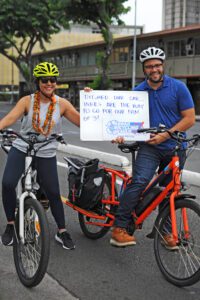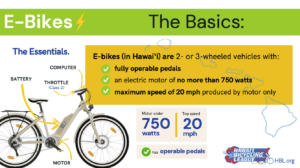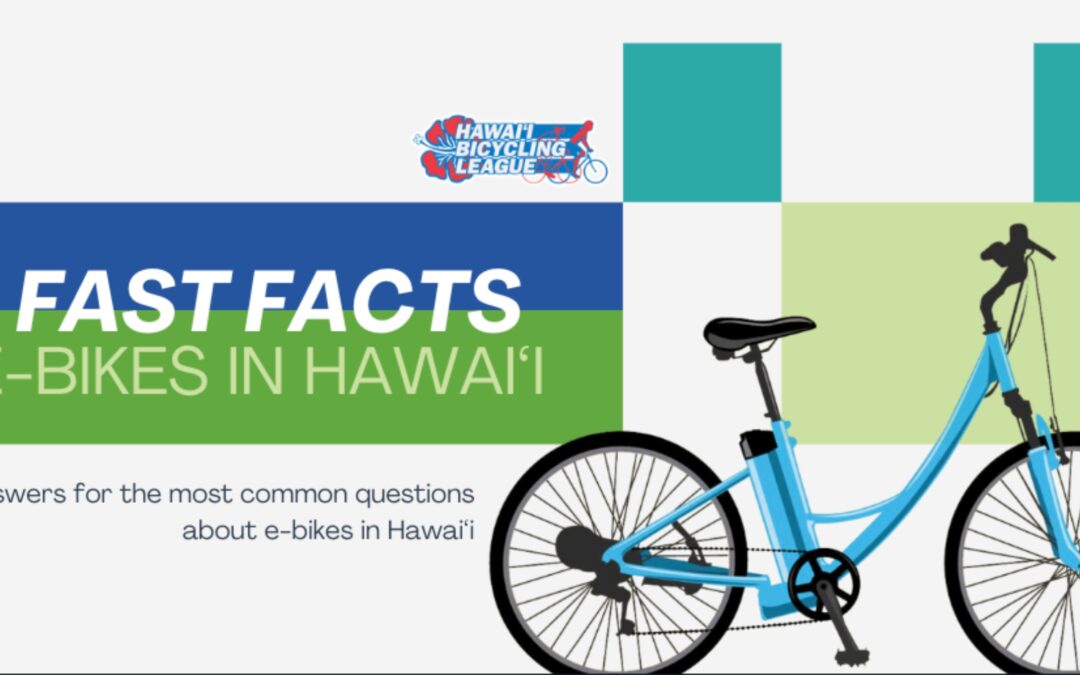YOUR E-BIKE QUESTIONS, ANSWERED!
Why E-Bike?
The Many Benefits of going electric
 E-bikes make riding a bicycle for transportation, recreation, and commuting easier & more convenient. The electric motor helps a rider conquer steep hills, bike long distances, carry heavy loads, and enjoy cycling a lot more, which makes biking more accessible and allows current bicycle users to bike more often and farther.
E-bikes make riding a bicycle for transportation, recreation, and commuting easier & more convenient. The electric motor helps a rider conquer steep hills, bike long distances, carry heavy loads, and enjoy cycling a lot more, which makes biking more accessible and allows current bicycle users to bike more often and farther.
What is an electric bike?
Laying down –legally– what Hawai‘i defines as an “e-bike”
An e-bike (or electric bike) can look a lot like a traditional bicycle except an e-bike is with an electric motor and rechargeable battery to provide the rider a power boost for climbing hills or traveling long distances. Some e-bikes provide assistance only when the rider is pedaling, while others have throttles and assist regardless of whether or not the pedals are being turned. 
Currently, Hawai‘i legally recognizes e-bikes as “low-speed electric bicycles,” as defined under title 15 United States Code section 2085 which clarifies the the term “low-speed electric bicycle” to mean:
What is NOT an E-bike:
There are many electrified two-wheeled vehicles zipping around the island, and many are easily mistaken or mislabeled as e-bikes. Here’s a simple test to see if it’s a “make-like” e-bike (aka NOT what Hawai‘i classifies as a low-speed electric bicycle)… It is NOT considered an e-bike if it has:
✖ no operable pedals
✖ a motor more than 750 watts (1 hp)
✖ a motor that continues providing assistance over 20 mph
Misrepresentation of these vehicles as e-bikes can lead to lack of trust and confusion, and ultimately can harm the e-bike industry and the efforts to promote sustainable transportation.
https://www.khon2.com/living-808/e-bike-safety-tips-from-local-experts/
Misrepresentation of these vehicles as e-bikes can lead to lack of trust and confusion, and ultimately can harm the e-bike industry and the efforts to promote sustainable transportation.
Where can e-bikes be ridden?
Short answer: same as where (traditional) bicycles can be ridden
In Hawai‘i, e-bikes are permitted wherever traditional bicycles are allowed – which is
roadways (minus the freeway) and bike infrastructure such as bike lanes, protected bike lanes, and multi-use paths.
Just as others on the roadway, all drivers (including those operating cars, bicycles, & e-bikes) should follow the rules of the road and obeying all traffic signals and signs. Those riding bicycles (electric or otherwise) on the road have the same rights and duties as drivers.
What about riding on sidewalks?
Bicycles, including e-bikes, are allowed to be ridden on sidewalks in residential areas, provided they yield to all pedestrians, give an audible signal when passing, and are traveling at speeds no faster than 10 mph. Bike riding is not legal on sidewalks outside of residential areas (such as business districts like Waikīkī), and can be risky for not only for pedestrians using the sidewalk as intended but for the rider as well.
Who are e-bikes for?
Responsible people who want to make pedaling easier.
E-bikes are for people (current cyclists and new-comers too) commuting to work, hauling groceries with ease, getting exercise, having fun, and more.

In Hawai‘i, those aged 15 and older can operate an e-bike as long as it’s registered under a household member.
E-bikes are vehicles and should be operated by responsible individuals, especially in places shared with others (roadways, bike lanes, etc.). Like other vehicles with motors (e.g. cars, mopeds), e-bikes can give the operator power and speed they wouldn’t naturally have, so it is very important the driver understands how to use their vehicle, drives in a predictable manner, and follows all traffic laws.

Before getting on an e-bike you should know your rights– and responsibilities on the road. Knowing your local laws (and abiding by them!) is essential to (giving a good name to those on 2-wheels) and having a safe & enjoyable e-biking experience.
Hawai‘i State E-Bike Laws
– Fast Facts –
Minimum Age
Age minimum for e-bike riders is 15 years old.
Helmet Requirement
A properly fastened helmet is required when bicycling for riders under 16 years of age.
License and Registration
Registration is required for those operating an e-bike on public roadways ($30 one-time fee for e-bikes). Driver’s license and insurance is not required.
Speed Limit
E-bikes may not exceed 20 mph when being powered by the electric motor. Note: the motor will cease providing assistance at it’s “top assisted speed”, but the rider can keep pedaling faster to make the e-bike go faster.
Where Allowed
E-bikes are allowed on any roadway, lane, or path that traditional bicycles are allowed on, including shared-use paths.
Safety Tips for Sharing the Road:
For e-bike riders:
» Know the rules of the road, and follow them. Obey traffic signals and stop signs. Ride with traffic; use the rightmost lane headed in the direction you are going.
» Be predictable. Make your intentions clear to everyone on the road. Ride in a straight line and don’t swerve between parked cars. Signal turns, and check behind you well before turning or changing lanes.
» Be conspicuous. Position yourself to be seen, avoid blindspots, and use a front white light, red rear light and reflectors when visibility is poor.
» Think ahead. Anticipate what drivers, pedestrians, and other people on bikes will do next. Watch for turning vehicles and ride outside the door zone of parked cars. Look out for debris, potholes, and other road hazards. Cross railroad tracks at right angles.
» Ride ready. Check that your tires are sufficiently inflated, brakes are working, chain runs smoothly, and quick release levers are closed. Carry tools and supplies that are appropriate for your ride. Wear a helmet.
For drivers:
» Know the rules of the road, and follow them. Obey traffic signals and come to a complete stop at the stop line at stop signs & red lights; use proper blinkers before turning, put your phone down & never do anything that would distract you from driving.
» Give (at least) 3ft of space. When passing a bicyclist, you are required by Hawai‘i law to allow at least 3 feet of space between your vehicle and the bicyclist.
» Check for bicyclists before making a turn. Yield to bicyclists and do not underestimate their speed. Watch for oncoming bicycle traffic when turning left. Do not pass and then cut in front of a bicyclist when turning right. Check all mirrors and blind spots for bicyclists.
» Respect the bike lane. Do not park, drive, or stand in the bike lane – even if bicyclists are not present at the time. If you need to cross a bike lane take the time to look & yield!
» Prevent dooring. Look back before opening your vehicle’s door to ensure that you are not opening your door into the path of a bicycle rider.

